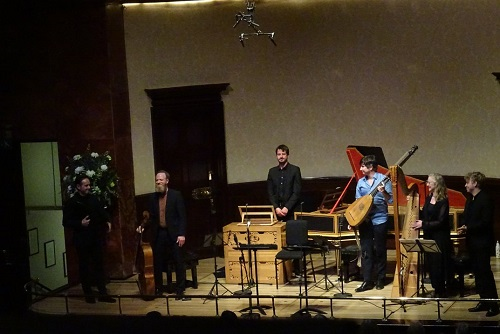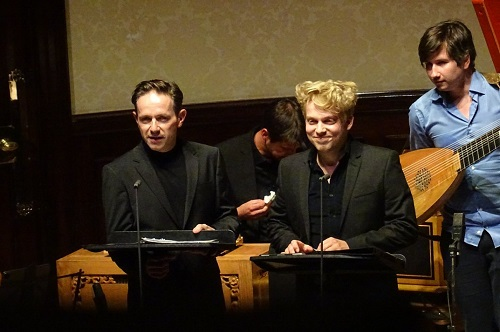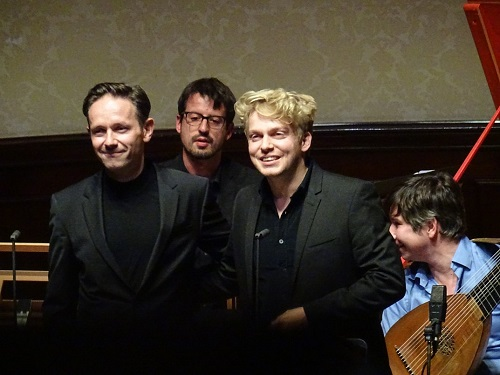This truly lovely recital represented the fruits of the introduction of the basso continuo at the end of the sixteenth century, which liberated polyphonic voices from their fundamental harmonic role and opened up opportunities for new vocal combinations and styles – and for vocal displays both virtuosic and theatrical. The polyphonic madrigal for three or more voices developed into the duet madrigal for two singers supported by continuo, and this form in turn evolved in the chamber duet, in which alternating solos and recitative were framed by an opening and closing duet.
By the end of the seventeenth century, these ‘duetti da camera’ were fully established as a genre in which the two voices were ‘equal partners’, often developing musical ideas in collaboration, performing the same text. In contrast to the conflict and opposing sentiments expressed by the characters in opera, these duets seek to exploit interlacing melodies, harmonic nuance and responsive instrumental textures to achieve an affecting expressive intensity – an aesthetic intent which the lyrics were often directly written to serve. At Wigmore Hall, in the first recital of his season residency at the Hall, Iestyn Davies was joined by the 2021 Kathleen Ferrier Award winner Hugh Cutting, and the duo, accompanied by Ensemble Guadagni, gave the capacity audience a masterclass in exquisite vocal theatre, creating intimate love scenes of passion, pain and sweetness.

Composers such as Bononcini, Lotti, Porpora, Marcello and Handel contributed masterpieces to the genre, but it was perhaps Claudio Monteverdi who exploited the genre most fully – ‘Zefiro torna’ from the Sesto Libro De Madrigali (1614) being one of the best-known early examples, prompting further development and experimentation in the Settimo Libro del Madrigali of 1619. So, it was fitting that the duo opened their programme with Monteverdi’s ‘Interrotte speranze’ (Hope cut short) from that Seventh Book. Gaurini’s sonnet is dark and burns with bitterness, and the low pedal that supports the opening phrases was tense, Thomas Dunford’s lute seeming to bristle with the poet-speaker’s repressed anguish. The initial vocal unisons, slowly rising, were lanced by tortured semitones, as Monteverdi harmonically underscores the lover’s lament. With the sestet, the lines began to fall, the semitones widening into thirds, but the emotional screw was tightened in the final tercet, making the duo’s slight relaxation – of weary resignation, perhaps – when the poet speaks of his own art – the gift of ‘harsh and bitter torments’ that he sends ‘the cruel woman’ – even more poignant.
In just a few minutes Davies and Cutting had confirmed the emotive power and pathos that can be achieved by two voices. Prior to the performance, I had wondered how their voices would blend: Cutting’s countertenor, which I greatly admired in a recent performance of Flight at the RCM, has seemed to me more ‘plump’ than Davies’ elegant, finely polished instrument. But, in fact, though Cutting perhaps used his voice more ‘freely’, while Davies’ control of his craft was poise personified, they were perfect partners. As the recital progressed there were times, if one shut one’s eyes it was difficult to tell their voices apart. The joyful thirds and sixths, and excited repetitions of Monteverdi’s ‘Vorrei baciarti’ (I want to kiss you) seemed to overflow with sublime, erotic elation. The ornate musical imagery of Antonio Lotti’s ‘Crudeltà rimproverata’ (Cruelty reproached) – water dropping onto marble rendered as leaping instrumental octaves, the marble then shattering with burning sparks as the voices quivered – was potent, and the vocal agility and range of both singers was impressive.

The ‘wash’ of rich continuo sound was quite intense in these three opening items, and sometimes a little obtrusive, but subsequently the ensemble struck a better balance. And, in Giovanni Bononcini’s ‘Pietoso nume arcier’ (Kindly archer-god), as Dorinda and Armida bemoaned their unfaithful lovers the continuo matched the sophistication of their imitative interlacing. The opening duet was decorated with elegance, all the more affecting for the expressive restraint and refinement; but the recitative had vigour and momentum, leading to a dance-like close, rippling with hope that love would prove true.
Benedetto Marcello’s ‘Felice chi vi mira’ (Happy he who beholds you) had a delightful exuberance, the voices nimble and bright, and relishing the sweetness of the music’s sighs which inspire a sympathetic passion in the loved one. The sarabande from Handel’s Suite in D Minor led segue to ‘Caro autor di mia doglia’ which dates from the composer’s early Italian years, and the latter was given an energised reading, Byers’s bass line buoyant and characterful. The attention to details and subtleties was notable: for example, the heightening of the repetitions, “Mio respiro, mia pace!” (my breath, my peace!) and the perfectly synchronised decorations of the final repetition; the driving impetus of the marked rhythms, “Nò, nò, che d’altrui che di te mai non sarò.” (No, I will never be for anyone other than you.); the pictorial madrigalisms on the word “fuggirà”, as discord flees.
The two countertenors also performed some solo songs. Alessandro Grandi’s ‘O quam tu pulchra es’ may announce itself as sacred monody, setting text from the Song of Songs, but Cutting made it the love song that it really is, his rich tone filling out the expansive, reflective phrases as the poet-speaker ruminates on his lover’s beauty, as Dunford exploited the harmonic colour, and dissonance, to intensify the sensuality of the sustained ‘O’ of the titular phrase which binds the song. Cutting’s directness of expression was utterly engaging and the low, sinking close touchingly captured the paradoxical hope and pain of the pining poet: “Surge, veni, quia amore langueo.” (Arise, come, how I languish in love.)

Davies made the flowing melismas of Monteverdi’s ‘Ego flos campi’ as smooth as silk, and he used the low register of the vocal line to wonderfully balance the mystical quality of the text with the suggestion of physical ecstasy. This song was a sort of aural complement to a Bernini sculpture. In the composer’s ‘Sì dolce è’l tormento’, Cutting showed how a strophic song of seeming naivety can convey astonishingly complex feeling, inter-verse elaborations from Dunford and Byers enhancing the impact of the simple, scalic vocal line. Girolamo Frescobaldi’s ‘Se l’aura spira tutta vezzosa’ had a lovely ‘lift’, and Davies decorated the strophic variations beautifully, building persuasively to the final plea, “Al canto, ninfe ridenti,/ Scacciate i venti di crudeltà.” (With your song, sweet maidens, drive away the winds of cruelty.)
I didn’t want the lovers’ quarrel in Bononcini’s ‘Sempre piango e dir non so’ (Endlessly I weep and cannot tell) to end. Never can conflict, accusations and infidelities have sounded so beguiling. Davies’ phrasing was stunning here, a simple falling gesture breathtaking in its beauty and emotive impact. Handel’s only operatic duet for two alto castrati (Senesino and Pacini), ‘Coronata di gigli e di rose’ from the final scene of Tamerlano, brought the programme to a close – a dulcet message of hope and harmony as Tamerlano, moved by Bajazet’s death, pardons Asteria, gives her hand in marriage to Andronico and agrees to honour his betrothal to Irene.
Interspersed between the vocal items were two of Giovanni Girolamo Kapsberger’s Toccatas, the sixth and first, originally for solo theorbo but arranged here to allow the members of Ensemble Guadagni to engage with Dunford’s archlute. As always, Dunford’s faerie fingers injected mischief and magic into the music – which sounded entirely ‘modern’, sometimes threatening waywardness but kept in rein by the lutenist’s astonishing technical command and hypnotising artistry.
This was a gorgeous recital, vibrantly emotive and musically uplifting. The musicians generously gave us two encores: Purcell’s ‘Sound the trumpet’ and a very welcome reprise of Sances’s ‘Lagrimosa beltà’. If there is such a thing as a countertenor-heaven, then it felt as if we’d been there.
The concert was broadcast live on BBC Radio 3 and is available on BBC Sounds for 29 days.
Claire Seymour
Iestyn Davies (countertenor), Hugh Cutting (countertenor), Ensemble Guadagni (Tom Foster – organ, harpsichord; Thomas Dunford – archlute, Jonathan Byers – cello, Siobhán Armstrong – harp)
Claudio Monteverdi – ‘Interrotte speranze’ SV132, ‘Vorrei baciarti’ SV123; Antonio Lotti – ‘Crudeltà rimproverata’ Op.1 No.6; Giovanni Girolamo Kapsberger – Toccata No.6; Alessandro Grandi – ‘O quam tu pulchra es’; Monteverdi – ‘Ego flos campi’ SV301, ‘Sì dolce è’l tormento’ SV332; Girolamo Frescobaldi – ‘Se l’aura spira tutta vezzosa’; Giovanni Bononcini – ‘Pietoso nume arcier’; Giovanni Felice Sances – ‘Lagrimosa beltà’; Benedetto Marcello – ‘Felice chi vi mira’; George Frideric Handel – Suite in D minor HWV437 Saraband, ‘Caro autor di mia doglia’ HWV182b; Kapsberger – Toccata No.1; Bononcini – ‘Sempre piango e dir non so’; Handel – Tamerlano HWV18 ‘Coronata di gigli e di rose’
Wigmore Hall, London; Wednesday 21st September 2022.
ABOVE: Iestyn Davies and Hugh Cutting